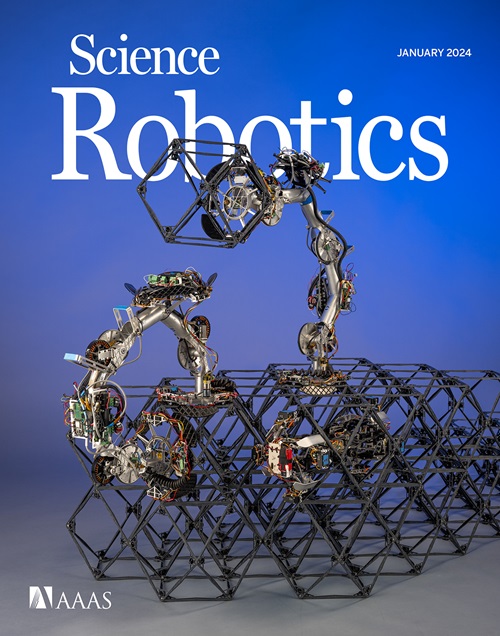A hyperelastic torque-reversal mechanism for soft joints with compression-responsive transient bistability
IF 26.1
1区 计算机科学
Q1 ROBOTICS
引用次数: 0
Abstract
Snap-through, a rapid transition of a system from an equilibrium state to a nonadjacent equilibrium state, is a valuable design element of soft devices for converting a monolithic stimulus into systematic responses with impulsive motions. A common way to benefit from snap-through is to embody it within structures and materials, such as bistable structures. Torque-reversal mechanisms discovered in nature, which harness snap-through instability via muscular forces, may have comparative advantages. However, the current intricacy of artificial torque-reversal mechanisms, which require sophisticated kinematics/kinetics, constrains design possibilities for soft joints and devices. Here, we harnessed hyperelasticity to implement a torque-reversal mechanism in a soft joint, generating repetitive cilia-like beating motions through an embedded tendon. The developed hyperelastic torque-reversal mechanism (HeTRM) exhibits transient bistability under a specific compressive displacement/force threshold, with snap-through occurring at the point where the transience ends. To validate the effectiveness of this design principle, we explored the functionalities of HeTRM in energy storage and release, dual modes for impulsive and continuous motion, mechanical fuse, and rapid three-dimensional motions, through proof-of-concept soft machines. We expect that this design principle provides insight into incorporating snap-through behavior in soft machines and may aid in understanding the relationship between torque-reversal mechanisms and bistability.
求助全文
约1分钟内获得全文
求助全文
来源期刊

Science Robotics
Mathematics-Control and Optimization
CiteScore
30.60
自引率
2.80%
发文量
83
期刊介绍:
Science Robotics publishes original, peer-reviewed, science- or engineering-based research articles that advance the field of robotics. The journal also features editor-commissioned Reviews. An international team of academic editors holds Science Robotics articles to the same high-quality standard that is the hallmark of the Science family of journals.
Sub-topics include: actuators, advanced materials, artificial Intelligence, autonomous vehicles, bio-inspired design, exoskeletons, fabrication, field robotics, human-robot interaction, humanoids, industrial robotics, kinematics, machine learning, material science, medical technology, motion planning and control, micro- and nano-robotics, multi-robot control, sensors, service robotics, social and ethical issues, soft robotics, and space, planetary and undersea exploration.
 求助内容:
求助内容: 应助结果提醒方式:
应助结果提醒方式:


